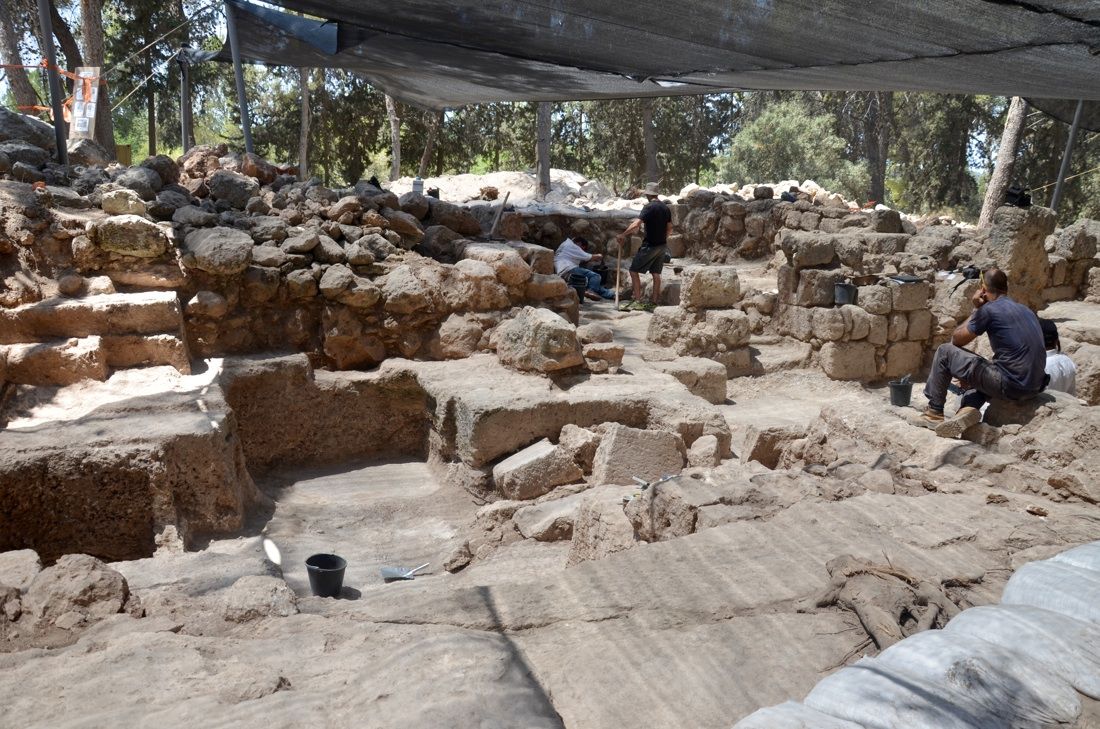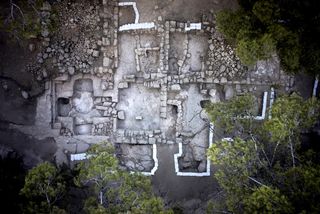Long-Lost Tomb of Jewish 'Maccabee' Rebels Possibly Found

An "unusual" new archaeological find could be the long-lost Tomb of the Maccabees, a burial site of leaders of a band of Jewish rebels from the second century B.C.
Israeli archeologists discovered the strange, pillared structure at the Horbat Ha-Gardi site near the ancient city of Modi'in. First excavated 150 years ago, this site was thought to be the mausoleum of a priest named Mattathias the Hasmonean and his five sons, who led a rebellion against Greek rule of Judea. Later study suggested it was instead an early Christian site, from several hundred years later.
The new excavations haven't fully solved the mystery, but archaeologists say they can't rule out that the Maccabees were buried there.
"If what we uncovered is not the Tomb of the Maccabees itself, then there is a high probability that this is the site that early Christianity identified as the royal funerary enclosure [for the Maccabees], and therefore, perhaps, erected the structure," Dan Shachar and Amit Re'em, the directors of the excavation for the Israel Antiquities Authority, said in a statement. [See Images of the Possible Tomb of the Maccabees]
The story of the Maccabees
Alexander the Great conquered Judea, in what is now southern Israel, from the Persians in 332 B.C. After Alexander's death, his empire fractured. Judea came under the rule of the Seleucid Empire, which stretched from modern-day Turkey through the Middle East all the way into northwest India.

The Seleucids were a Hellenistic dynasty, and they aggressively moved to bring a Greek influence to Judea. According to the historical Hebrew text 1 Maccabees, the ruler Antiochus IV Epiphanes suppressed Jewish law and outlawed rites such as circumcision. He also instituted pagan rituals at the holy Second Temple in Jerusalem, desecrating it in the eyes of the Jewish residents.
Sign up for the Live Science daily newsletter now
Get the world’s most fascinating discoveries delivered straight to your inbox.
Then, the story goes, a Jewish priest named Mattathias (or Matityahu) rebelled. He and his five sons launched a campaign against the Hellenistic rulers. Mattathias died in 166 B.C. or so, and his son Judah took over as leader of the rebel army. In 165 B.C., the rebels successfully wrested control of Judea from the Seleucid dynasty, liberating the temple.
It was during the liberation and re-dedication of the temple that the festival of Hanukkah was born. According to the Talmud (the central Hebrew text of Judaism), the victorious Jews could find only one flask of holy, sealed olive oil, which was needed to burn constantly to cleanse the temple. Miraculously, the single flask burned for eight days, keeping the flame alive until more holy oil was found.
Lost mausoleum
The victory of the Maccabees made Judea a semi-autonomous region within the Seleucid Empire and launched the Hasmonean dynasty. Judah, the first ruler of the dynasty, continued the battle to conquer back more territory after reclaiming the Temple, but died on the battlefield in 160 B.C. His brother Jonathan took the throne until he was assassinated in 142 B.C., and was then succeeded by his younger brother Simon. Simon's son-in-law murdered him in 134 B.C. and took the throne. The royal burial places have never been found.
When Antiochus died in 129 B.C., Judea became independent. The Hasmoneans ruled until becoming a client kingdom of Rome in 63 B.C. Their dynasty held on until the Roman Senate appointed Herod king in 37 B.C. [In Photos: The Controversial 'Tomb of Herod']
About 150 years ago, archaeologists first excavated at the Horbat Ha-Gardi site, suspecting that it might hold the remains of the ancient city of Modi'in. They found a mausoleum built upon huge pillars, supporting slabs that might once have been the floor of a second story. The discoverers declared that the ruins matched the historical descriptions of the tomb of the Maccabee rulers, according to the Israel Antiquities Authority. That tomb was said to overlook the sea and to bear pyramid-shaped roofs.
Soon, though, the French archaeologist Charles Simon Clermont-Ganneau threw a wrench into the narrative. Clermont-Ganneau, who conducted excavations in the Middle East through the 1870s and 1880s, discovered mosaics with crosses on them in the burial vault floors. He suspected that the structure dated to the early days of Christianity, though it might have been built over the original tomb of the Maccabees to celebrate them, he wrote.
Now, the Israel Antiquities Authority is on the hunt for answers. Archaeologists and local volunteers have excavated the old site in recent weeks, according to the authority, and found the same burial vaults and pillars described by 19th-century researchers.
"To our disappointment, the building seen by our predecessors has been robbed, and its stones were taken to construct settlements in the vicinity," Re'em and Shachar said in a statement. "Nevertheless, the appearance of the place is impressive and stimulates the imagination."
More work, however, will be needed to determine whether the site is the Maccabees' tomb, a later Christian monument to them or something else altogether, Re'em and Shachar said.
"The search for the elusive Tomb of the Maccabees continues," the archaeologists said.
Follow Stephanie Pappas on Twitter and Google+. Follow us @livescience, Facebook & Google+. Original article on Live Science.

Stephanie Pappas is a contributing writer for Live Science, covering topics ranging from geoscience to archaeology to the human brain and behavior. She was previously a senior writer for Live Science but is now a freelancer based in Denver, Colorado, and regularly contributes to Scientific American and The Monitor, the monthly magazine of the American Psychological Association. Stephanie received a bachelor's degree in psychology from the University of South Carolina and a graduate certificate in science communication from the University of California, Santa Cruz.










